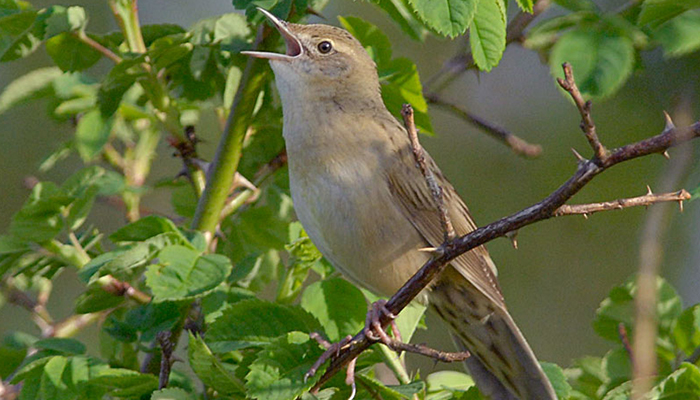
English: Common Grasshopper
Warbler, Pale Grasshopper-warbler
Russian: Обыкновенный сверчок
Mongolian: Эгэл шатансүүлт
German: Feldschwirl
French: Locustelle tachetee
Japanese: ヤチセンニュウ (Yachi-sennyu)
Body length: 12 ½ - 13 ½ cm.
Breeds in habitats with low,
thick vegetation, often in tussocky marshland beside lakes (where tussocks
tallest), in young conifer plantations or clear-felled areas, among tall grass
and herbage with scattered bushes, often along riversides. Summer visitor (in
Britain & Ireland May-Jul), winters so far as known in tropical Africa.
Except when singing, very hard to see; keeps well concealed and creeps in grass
like a mouse. Nests low in dense vegetation.
Identification: A Sedge
Warbler-sized, grey-brown bird with no striking plumage features. Dark-spotted
above on olive-tinged grey-brown ground; off-white or sometimes warmer buffy
yellow-white below, unspotted or with variable amount of small dark spots only
on throat and upper breast (many have a few spots only; rarely, showing dense
heavy spotting, and in addition some diffuse streaking on flanks, producing
similarity to Lanceolated Warbler, which see). Distinguished from Sedge Warbler
by: lack of prominent, diffusely streaked undertail-coverts; olive-tinged
grey-brown and weakly dark-spotted rump not contrasting appreciably with back;
evenly fine-streaked crown without darker sides. Legs pinkish, bill rather
dark. Tertials dark, with bases broadly and diffusely edged brown. Sexes alike.
In autumn, juveniles are often yellowish below while adults are off-white,
although there seems to be a certain overlap as to this.